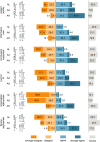Nobel and novice: Author prominence affects peer review
- PMID: 36194633
- PMCID: PMC9564227
- DOI: 10.1073/pnas.2205779119
Nobel and novice: Author prominence affects peer review
Abstract
Peer review is a well-established cornerstone of the scientific process, yet it is not immune to biases like status bias, which we explore in this paper. Merton described this bias as prominent researchers getting disproportionately great credit for their contribution, while relatively unknown researchers get disproportionately little credit [R. K. Merton, Science 159, 56-63 (1968)]. We measured the extent of this bias in the peer-review process through a preregistered field experiment. We invited more than 3,300 researchers to review a finance research paper jointly written by a prominent author (a Nobel laureate) and by a relatively unknown author (an early career research associate), varying whether reviewers saw the prominent author's name, an anonymized version of the paper, or the less-well-known author's name. We found strong evidence for the status bias: More of the invited researchers accepted to review the paper when the prominent name was shown, and while only 23% recommended "reject" when the prominent researcher was the only author shown, 48% did so when the paper was anonymized, and 65% did when the little-known author was the only author shown. Our findings complement and extend earlier results on double-anonymized vs. single-anonymized review [R. Blank, Am. Econ. Rev. 81, 1041-1067 (1991); M. A. Ucci, F. D'Antonio, V. Berghella, Am. J. Obstet. Gynecol. MFM 4, 100645 (2022)].
Keywords: double-anonymized; peer review; scientific method; status bias.
Conflict of interest statement
The authors declare no competing interest.
Figures


Similar articles
-
How to write an effective journal peer review using a staged writing approach: a best-practice guide for early-career researchers.Int J Epidemiol. 2024 Oct 13;53(6):dyae154. doi: 10.1093/ije/dyae154. Int J Epidemiol. 2024. PMID: 39570678 Free PMC article.
-
Writing a scientific publication for a management journal.J Health Organ Manag. 2008;22(2):189-206. doi: 10.1108/14777260810876349. J Health Organ Manag. 2008. PMID: 18700528
-
The role of author identities in peer review.PLoS One. 2023 Jun 21;18(6):e0286206. doi: 10.1371/journal.pone.0286206. eCollection 2023. PLoS One. 2023. PMID: 37342992 Free PMC article.
-
Co-reviewing and ghostwriting by early-career researchers in the peer review of manuscripts.Elife. 2019 Oct 31;8:e48425. doi: 10.7554/eLife.48425. Elife. 2019. PMID: 31668163 Free PMC article.
-
Peer review: issues in physical medicine and rehabilitation.Am J Phys Med Rehabil. 2003 Oct;82(10):790-802. doi: 10.1097/01.PHM.0000087607.28091.B7. Am J Phys Med Rehabil. 2003. PMID: 14508411 Review.
Cited by
-
The persistence of very low correlations between NIH research funding and disease burdens.Public Health Pract (Oxf). 2024 Dec 21;9:100580. doi: 10.1016/j.puhip.2024.100580. eCollection 2025 Jun. Public Health Pract (Oxf). 2024. PMID: 39850028 Free PMC article.
-
How to improve scientific peer review: Four schools of thought.Learn Publ. 2023 Jul;36(3):334-347. doi: 10.1002/leap.1544. Epub 2023 Apr 27. Learn Publ. 2023. PMID: 38504796 Free PMC article.
-
Scientific sinkhole: estimating the cost of peer review based on survey data with snowball sampling.Res Integr Peer Rev. 2023 Apr 24;8(1):3. doi: 10.1186/s41073-023-00128-2. Res Integr Peer Rev. 2023. PMID: 37088838 Free PMC article.
-
A guide for social science journal editors on easing into open science.Res Integr Peer Rev. 2024 Feb 16;9(1):2. doi: 10.1186/s41073-023-00141-5. Res Integr Peer Rev. 2024. PMID: 38360805 Free PMC article.
-
Testing for reviewer anchoring in peer review: A randomized controlled trial.PLoS One. 2024 Nov 18;19(11):e0301111. doi: 10.1371/journal.pone.0301111. eCollection 2024. PLoS One. 2024. PMID: 39556577 Free PMC article. Clinical Trial.
References
-
- Kronick D. A., Peer review in 18th-century scientific journalism. JAMA 263, 1321–1322 (1990). - PubMed
-
- Merton R. K., The Matthew effect in science. The reward and communication systems of science are considered. Science 159, 56–63 (1968). - PubMed
-
- Cox D., Gleser L., Perlman M., Reid N., Roeder K., Report of the ad hoc committee on double-blind refereeing. Stat. Sci. 8, 310–317 (1993).
-
- Blank R., The effects of double-blind versus single-blind reviewing: Experimental evidence from the American Economic Review. Am. Econ. Rev. 81, 1041–1067 (1991).
-
- Peters D., Ceci S., Peer-review practices of psychological journals: The fate of published articles, submitted again. Behav. Brain Sci. 5, 187–195 (1982).
Publication types
MeSH terms
LinkOut - more resources
Full Text Sources

